In this two-part series, we spoke to colleagues from Mariposa Community Health Center, Nogales AZ;, St John’s Well Child and Family Center, Los Angeles CA;, and Northwest Regional Primary Care Association, Seattle WA, to learn more about the role of CHWs in the community health center landscape. Part 2, ‘Community Health Workers in the Community Health Center Setting’ can be accessed here.
‘Comer Bien’ (Eat Well), Mariposa Community Health Center, Nogales AZ
Community health workers have long been a part of Mariposa Community Health Center. Situated in Nogales on the U.S./Mexico border, the health center serves a predominantly low-income, Mexican-American community where food insecurity is prevalent. Reflecting high food costs, lack of public transportation and low awareness of the role of healthful diet and nutrition, nearly 14% of the health center’s patients suffer from diabetes and other chronic health conditions. Mariposa CHC launched the ‘Comer Bien’ (Eat Well) program in 2018, to address these issues with a specific focus on helping those with uncontrolled diabetes improve blood sugar control.
The Comer Bien program aims to bridge the food insecurity gap in this community and improve health outcomes through the FVRx Fruit and Vegetables Prescription Program, cooking classes, and transportation to the local farmers’ market and family-owned grocery stores. Integral to the ‘Comer Bien’ program are community health workers. In addition to conducting home visits and assessments, CHWs teach classes that incorporate culturally-specific recipes to support the nutritional needs of participants, offering both cooking tips and an exercise component, provide care management, and offer free transportation to local grocery stores. We spoke with members of the ‘Comer Bien’ team at Mariposa Community Health Center to find out more about the crucial role CHWs play at the health center, and in the community.
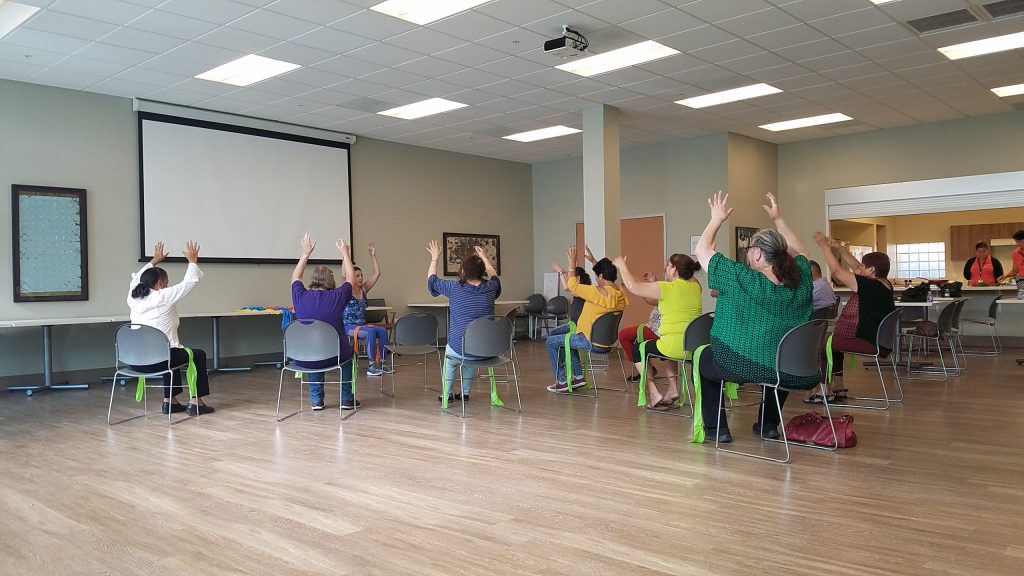
Participants of Mariposa CHC’s ‘Comer Bien’ (Eat Well) program take part in an exercise demonstration, (Nogales, AZ).
Patty Molina, Senior Director, Community Health Services
Why did you engage CHWs into the project?
Our department has been working with the CHW model since 1991. CHWs act as a bridge to healthcare and social services. They provide one-on-one and group education in a manner that is culturally sensitive. They have the time and the skills to identify and address social and economic needs, in addition to conducting home visits, which is really unique to the work that they can do. The CHWs also train community members to become lay leaders themselves, and we engage those lay leaders to provide peer support and facilitate community-focused activities. We have been instrumental as a leader in promoting CHWs and serving as a model, nationwide, for others wanting to implement the same structure within their organization.
How do CHWs address Social Determinants of Health (SDoH) in your community?
Within our community we’re primarily Hispanic, Spanish speaking. CHWs come from the community so they understand our cultural norms, values, and beliefs; they’re familiar with healthcare in both the United States and Mexico. CHWs understand the issues related to migratory status. Because they come from the same neighborhoods as many of our patients, they understand and identify with them and are trusted by the communities they serve. So they can help address the social determinants of health. They provide a lot of referrals to other resources in the community, such as food pantries and other social service provisions like SNAP and the food bank. They can also provide referrals to resources to help pay for water and electricity bills, or things like that outside of healthcare.
What are some unique community and cultural connections enhanced and understood by CHWs?
They’re really highly effective because they come from the same community, and reflect the demographics of the community. They wear many different hats; they do a variety of different activities including home visits, recruitment, assessments, health education, facilitation, patient care coordination, and they provide transportation to patients. We have very limited public transportation in our area and that is a huge barrier for a lot of people, so they take that on and provide transportation themselves. Our community, as any border community, is very unique compared to any other rural community. Border states are really different, there’s a uniqueness to the way we function and work. These CHWs truly understand that – they’re highly visible in the community and can readily respond to the cultural and linguistic needs of the community. They really are the heart and soul of everything that we do within community health services.
Lilliana Mendivil, Community Health Worker
What activities do you do in your role?
Right now, we are working on food demonstrations in the class, teaching healthy recipes for the participants to prepare at home. We try to provide them with recipes that will help lower sugar levels or that are generally healthier for them. We conduct home visits to see the home life of participants. We want to know where they live, as well as their relationship with family and what that means for their health. For example, we had a participant who had her toes amputated but she lived in a two-story apartment, so it was very difficult for her to walk up and down the stairs; it was one of the things we saw during the home visit.
Cecilia Mendez, Community Health Worker
What are some of the challenges?
CHWs need to gain people’s trust in order to open doors and be welcomed into their home. However once established, they are very loyal and very grateful because you are giving them food coupons and offering classes, One of the biggest barriers is still transportation. People cannot go to the store by themselves, they need somebody to help with groceries, and we try to get as many referrals as we can to find resources here in the community. We try to help all the participants with these basic needs.
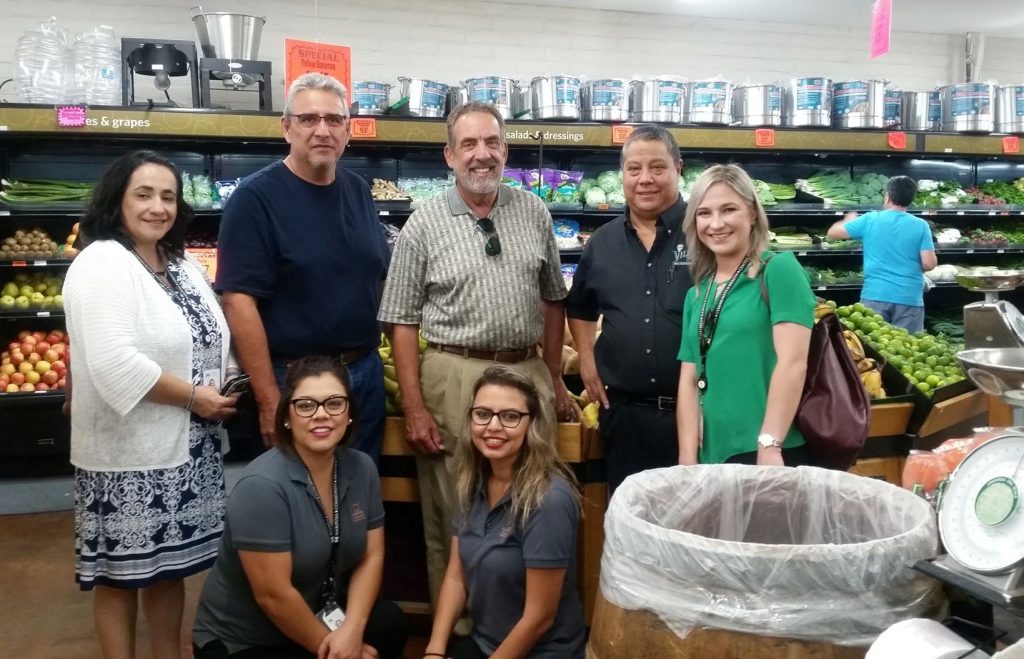
Mariposa Community Health Center and RCHN CHF staff alongside FVRx program collaborators from Villas Market, (Nogales, AZ).
Healthy Homes Healthy Kids, St. John’s Well Child and Family Center, Los Angeles, CA
St. John’s Well Child and Family Center (SJWCFC) in South Los Angeles provides a comprehensive medical home for nearly 83,000 people, including 2,500 children with asthma. Here, social determinants of health such as substandard housing disproportionately affect the community’s low-income and minority children and exacerbate chronic conditions like asthma. The Healthy Homes Healthy Kids project (HHHK) was launched in 2018 to address housing-related asthma triggers and improve health outcomes. In partnership with Strategic Actions for a Just Economy (SAJE), a community-based organization focused on tenants’ rights, healthy housing, and equitable development, HHHK is addressing housing problems to improve housing conditions that contribute to asthma exacerbations.
Integral to Healthy Homes Healthy Kids is the work of Nacira Torres, a community health worker at St. John’s Well Child and Family Center whose role conducting home visits, education, and information sharing, has been vital to the program. We spoke to Nacira and Opulence Abundance, Associate Director of Programs and Grant Management at SJWCFC to learn more about the impact of CHWs in their program.
Opulence Abundance, Associate Director of Programs and Grant Management
Why did you engage CHWs into the project?
So much of the work is about connecting to people. This project requires going into people’s homes and actually doing a home assessment, which is a really intimate encounter, socially considering that a lot of our patients live in public housing or have landlords who are reluctant to make repairs or engage in pest control. People can be sensitive about their homes, so we really needed someone who has that expertise as well as their own community experience. Also, when it comes to asthma management in the community, the need for someone proficient in communicating with other community members is so clear. So often people go to their doctor’s appointments and just don’t understand the directions, so that’s why we felt like this role is really important for this project.
How do CHWs address Social Determinants of Health (SDoH) in your community?
I think our community health workers are really experts on the needs of the people they see, and they’re also experts of their own lived experience and we really value that relevant knowledge. When you are looking at SDoH, it’s great that the CHWs can personally recognize them. CHWs are so intimately familiar with the SDoH that they are able to see a lot of the symptoms and connect them to the underlying root cause, and that makes them very valuable to the team.
It is a really valuable thing to feel like you have an advocate in the community and also in a system that might be hard to navigate or understand.
Absolutely, a lot of members of our community, especially the ones who receive outreach services and have the highest need for asthma care and asthma care management, are incredible people who are moving through a lot, often working multiple jobs. Often landlords are very reluctant to make repairs, oftentimes the residents feel like they may be in a power dynamic with their landlords. They’re doing so much to survive that there is a lot of vulnerability and there is a lot of fear. So to have someone to say, ‘I know your fears and you’re safe and I’m going to support you in improving the life of your child,’ I think it’s really powerful.
What are some unique community and cultural connections enhanced and understood by CHWs?
A key one – specific to St John’s – is that our CHWs understand what it’s like to live in South Central LA. Right now, there’s a lot of issues around air quality, as well as construction and oil. So having someone who understands those issues, someone who can also see the population and understand cultural nuances, is really important. People’s heritage and ethnicity is important and being able to communicate with them comfortably is important. Some people impacted the most in South Central are African American, and I think there’s something really beautiful about seeing Nacira in action in this cross-cultural environment, as well as seeing how [within] both populations you see a lot of solidarity and unity in action, it’s really powerful.
Nacira Torres, Community Health Worker
How did you join the HHHK Project?
I joined the HHHK Project as a health care promoter. I teach patients all about asthma signs, symptoms, and triggers, how to use non-toxic cleaning supplies, how to treat the symptoms with medications, how to identify asthma triggers at home, and how to prevent children from experiencing preventable emergency room visits and hospitalizations.
What activities do you do in your role?
I go to the homes, prepare the table with the kids’ supplies, and prepare to give asthma education. I explain to the family how to use the correct medication, inhale it, and how to take the medication, describing and demonstrating how to use and mirror those behaviors. I make an action plan, too.
What are some of the challenges?
One of the challenges in our community is the large population living below the poverty level. People lack transportation and in addition have general housing problems like a lot of bed bug infestations, multiple people living in one single apartment, and families living in overcrowded conditions. And they experience problems related to immigration.
How has your community and cultural understanding aided your work? Can you share an example?
I connect because a lot of families speak Spanish. The families feel comfortable with me because I explain everything in Spanish, and they understand because face-to- face interaction allows them to feel comfortable in the house. When I visit the families they ask, “do you need something, do you need water?”
Opulence: Part of what Nacira is saying is when Nacira goes to the house, it sounds like the family offers Nacira water or food and they have this exchange… and Nacira says yes I’d love a glass of water and even in those moments Nacira is seeing the dishes are cleaned with Clorox which is a huge asthma trigger and very dangerous.
Yes, so I say don’t clean with Clorox use baking soda and vinegar.
Opulence: I think that’s amazing that Nacira is able to use those little moments as teaching moments, but I also think that when you go there and they offer you food and you take some that’s a part of the cultural connection.
I have a deep connection to the family, and the kids – I love the kids.
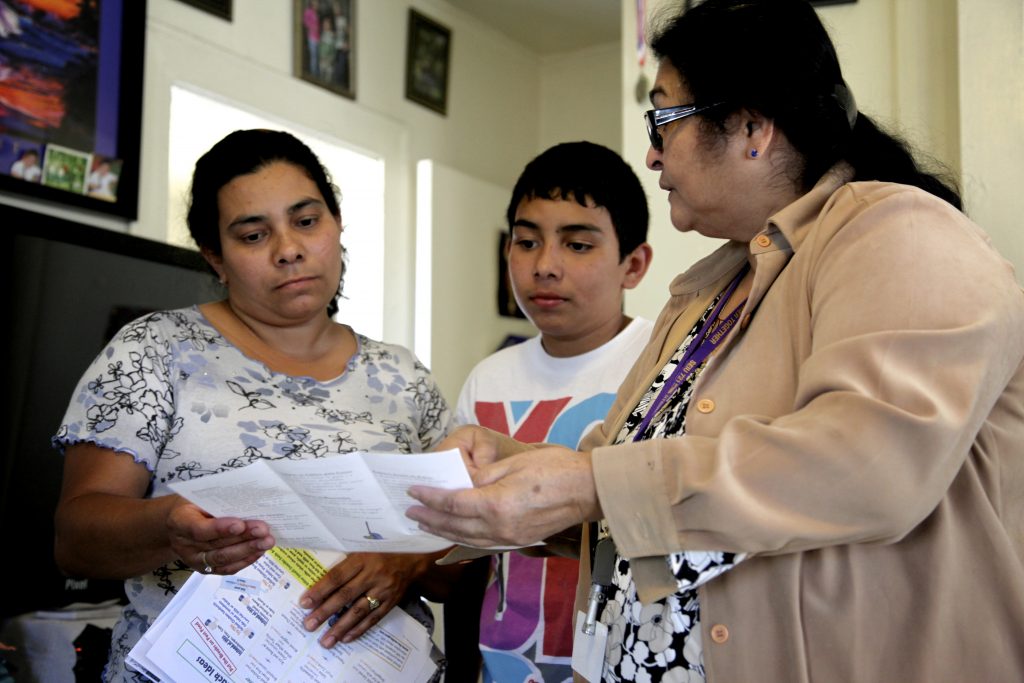
Silvia, a CHW for SJWCFC (right) conducting a home visit, (Los Angeles, CA).
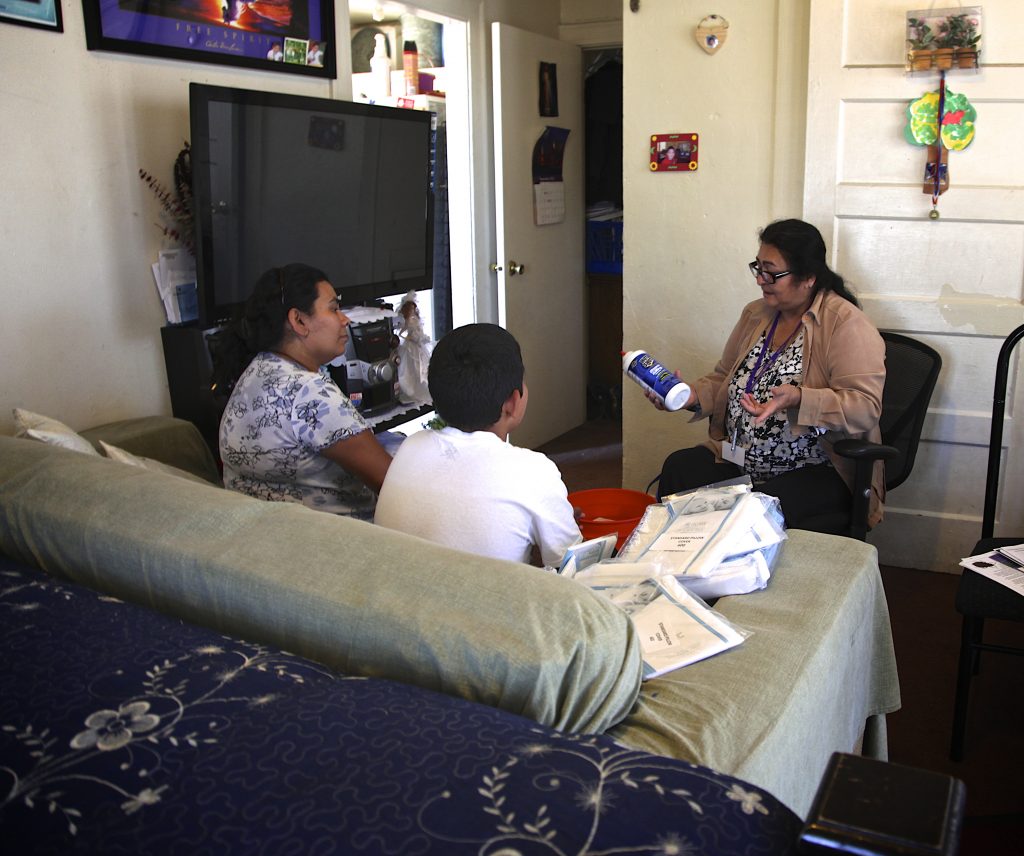
Silvia, a CHW for SJWCFC (right) conducting a home visit, (Los Angeles, CA).
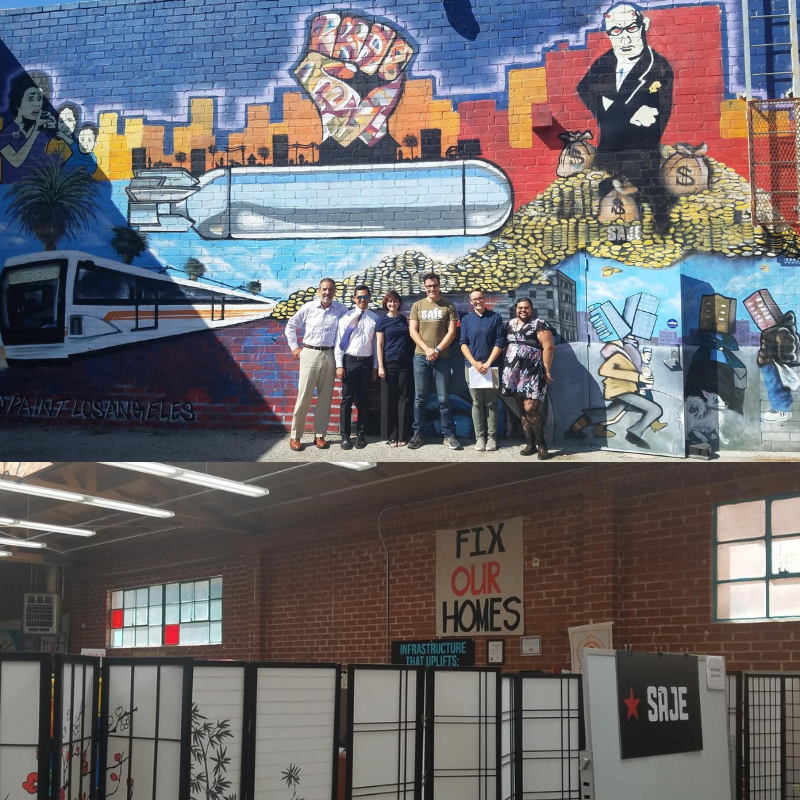
RCHN CHF and SJWCFC staff visit project partner, Strategic Actions for a Just Economy (SAGE), in Los Angeles, CA.
-Nela Abey, August 2019




